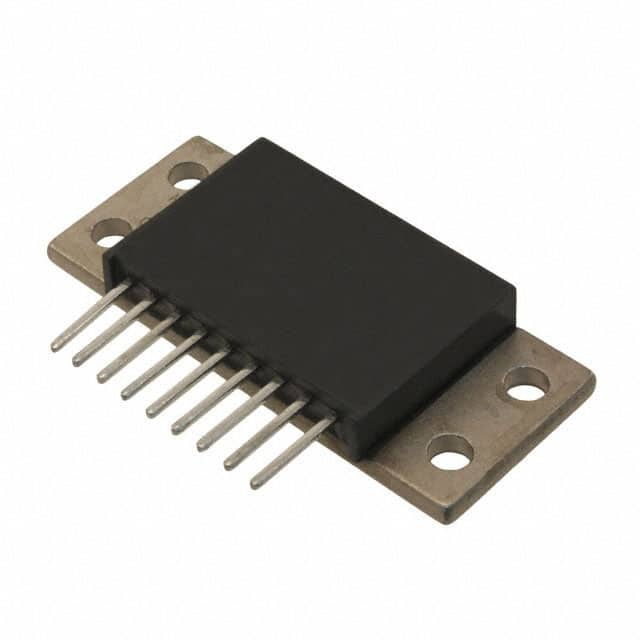151CMQ035
Product Overview
Category
The 151CMQ035 belongs to the category of Schottky diodes.
Use
It is commonly used in power supply applications, rectifiers, and reverse polarity protection circuits.
Characteristics
- Low forward voltage drop
- High current capability
- Fast switching speed
- High temperature operation
- Low leakage current
Package
The 151CMQ035 is typically available in a TO-220AB package.
Essence
This diode is essential for efficient power conversion and protection against reverse voltage.
Packaging/Quantity
It is usually packaged in reels or tubes and is available in varying quantities depending on the supplier.
Specifications
- Forward Voltage Drop: 0.55V at 15A
- Reverse Voltage: 35V
- Maximum Continuous Forward Current: 15A
- Operating Temperature Range: -65°C to 175°C
- Storage Temperature Range: -65°C to 175°C
Detailed Pin Configuration
The 151CMQ035 typically has three pins: 1. Anode 2. Cathode 3. Thermal pad (connected to the metal tab of the TO-220AB package)
Functional Features
- Low forward voltage drop ensures minimal power loss.
- Fast switching speed allows for efficient operation in high-frequency circuits.
- High current capability enables it to handle substantial power loads.
- High-temperature operation makes it suitable for demanding environments.
Advantages and Disadvantages
Advantages
- Efficient power conversion
- Fast response time
- High current handling capacity
Disadvantages
- Higher cost compared to standard silicon diodes
- Sensitive to voltage spikes and transients
Working Principles
The 151CMQ035 operates based on the Schottky barrier principle, where the metal-semiconductor junction allows for fast switching and low forward voltage drop.
Detailed Application Field Plans
Power Supply Units
Used in various power supply units for electronic devices, ensuring efficient energy conversion.
Rectifiers
Applied as rectifiers in AC to DC converters due to their low forward voltage drop and high current capability.
Reverse Polarity Protection Circuits
Utilized to protect sensitive electronic components from damage due to reverse voltage connection.
Detailed and Complete Alternative Models
- 151CMQ030
- 151CMQ040
- 151CMQ045
- 151CMQ050
In conclusion, the 151CMQ035 Schottky diode is a crucial component in power supply and rectification applications, offering efficient power conversion, fast switching speed, and high current handling capabilities. While it may have a higher cost and sensitivity to voltage spikes, its advantages make it a preferred choice in various electronic systems.
Word Count: 411
Senaraikan 10 soalan dan jawapan biasa yang berkaitan dengan aplikasi 151CMQ035 dalam penyelesaian teknikal
Sure, here are 10 common questions and answers related to the application of 151CMQ035 in technical solutions:
What is the maximum repetitive peak reverse voltage of 151CMQ035?
- The maximum repetitive peak reverse voltage of 151CMQ035 is 35V.
What is the maximum average forward rectified current for 151CMQ035?
- The maximum average forward rectified current for 151CMQ035 is 15A.
What is the typical junction capacitance of 151CMQ035?
- The typical junction capacitance of 151CMQ035 is 150pF.
What is the operating temperature range for 151CMQ035?
- The operating temperature range for 151CMQ035 is -55°C to +175°C.
Can 151CMQ035 be used in bridge rectifier applications?
- Yes, 151CMQ035 can be used in bridge rectifier applications.
What is the forward voltage drop of 151CMQ035 at 7.5A?
- The forward voltage drop of 151CMQ035 at 7.5A is typically 0.85V.
Is 151CMQ035 suitable for high-frequency switching power supplies?
- Yes, 151CMQ035 is suitable for high-frequency switching power supplies.
What is the maximum reverse recovery time of 151CMQ035?
- The maximum reverse recovery time of 151CMQ035 is typically 35ns.
Can 151CMQ035 be used in automotive electronic systems?
- Yes, 151CMQ035 can be used in automotive electronic systems.
Does 151CMQ035 have a UL recognition?
- Yes, 151CMQ035 has UL recognition under the component recognition program.
I hope these questions and answers are helpful for your technical solutions! If you need further information, feel free to ask.


